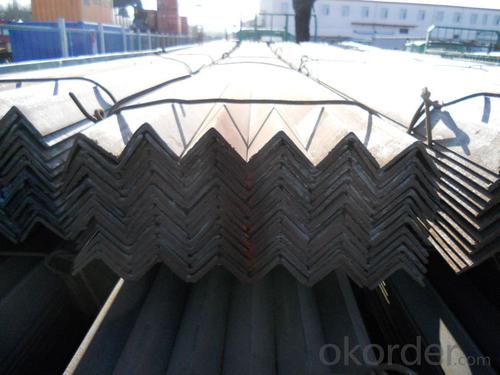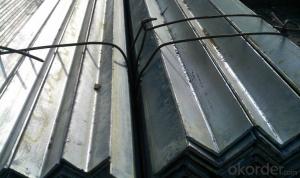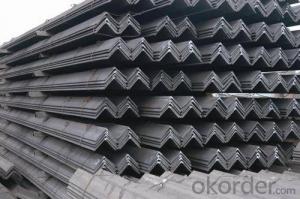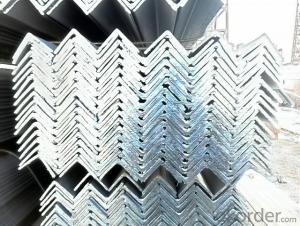Equal Steel Angle GB Standard
OKorder Service Pledge
OKorder Financial Service
You Might Also Like
Specifications of Equal Angle Steel
1.Standards:GB
2.Length:6m,9m,12m
3.Material:GBQ235,Q345 or Equivalent
4. Size:
Size (mm) | Mass (mm) | Size (mm) | Mass (mm) |
| 30*30*5 | 2.184 | 38*38*2.5 | 1.482 |
| 30*30*6 | 2.564 | 38*38*3 | 1.758 |
Usage & Applications of Equal Anlge Steel
Trusses;
Transmission towers;
Telecommunication towers;
Bracing for general structures;
Stiffeners in structural use.
Packaging & Delivery of Equal Angle Steel
1. Transportation: the goods are delivered by truck from mill to loading port, the maximum quantity can be loaded is around 40MTs by each truck. If the order quantity cannot reach the full truck loaded, the transportation cost per ton will be little higher than full load.
2. With bundles and load in 20 feet/40 feet container, or by bulk cargo, also we could do as customer's request.
3. Marks:
Color mark: There will be color marking on both end of the bundle for the cargo delivered by bulk vessel. That makes it easily to distinguish at the destination port.
Tag mark: There will be tag mark tied up on the bundles. The information usually including supplier logo and name, product name, made in China, shipping marks and other information request by the customer.
If loading by container the marking is not needed, but we will prepare it as customer request.
*If you would like to get our price, please inform us the size, standard/material and quantity. Thank you very much for your attention.
- Q: What are the common finishes available for steel angles?
- The desired aesthetic appeal and level of protection required will determine the available finishes for steel angles. Common finishes include: 1. Mill finish: The steel angle is left in its natural state after manufacturing, resulting in a rough, gray appearance with minimal corrosion resistance. 2. Hot-dip galvanized: By immersing the steel angle in molten zinc, a protective coating is created on the surface. This finish provides excellent corrosion resistance and is suitable for outdoor applications in harsh environments. 3. Powder coating: Dry powder is applied to the steel angle, then heated and cured to create a durable and decorative coating. Powder coating offers a wide range of colors and textures, along with good corrosion resistance. 4. Painted finish: Various types of paint, such as epoxy, enamel, or acrylic-based coatings, can be used to paint steel angles. Painting provides a decorative finish and can offer some degree of corrosion resistance, depending on the paint type and quality. 5. Stainless steel: Stainless steel angles have a distinct finish that is resistant to corrosion, staining, and rust. They are commonly used in industries like food processing and medicine, where hygiene, aesthetics, and longevity are important. When choosing the appropriate finish, it is important to consider the specific requirements of your project, including the environment and intended use of the steel angle. Consulting with a steel supplier or expert can help determine the best finish for your needs.
- Q: How are steel angles protected against chemical exposure?
- Steel angles can be protected against chemical exposure through various methods such as applying protective coatings, using corrosion-resistant materials like stainless steel, or implementing proper maintenance practices like regular cleaning and inspections.
- Q: How do steel angles perform under lateral or wind loading conditions?
- Steel angles are commonly used in construction and engineering applications due to their strength and versatility. When it comes to lateral or wind loading conditions, steel angles perform exceptionally well. Lateral loading refers to forces that act in a horizontal direction, perpendicular to the axis of the angle. Steel angles, with their inherent rigidity and ability to resist bending, are capable of withstanding significant lateral loads. This makes them ideal for applications such as bracing systems, support structures, and framing components that need to resist wind, seismic, or other lateral forces. Similarly, steel angles excel in wind loading conditions. Wind exerts a strong lateral force on structures, and steel angles can effectively counteract these forces. By securely fastening steel angles to the structure, they can provide stability and prevent the structure from being compromised by wind-induced vibrations or even collapse. The performance of steel angles under lateral or wind loading conditions can be further enhanced through proper design and installation. Engineers often consider factors such as the size and thickness of the angle, the type and quality of the steel used, and the connection details. By carefully analyzing the specific loading conditions and selecting appropriate steel angles, engineers can ensure that structures remain stable and safe, even under extreme lateral or wind loads. Overall, steel angles are highly reliable and durable when it comes to lateral or wind loading conditions. Their robustness, coupled with their cost-effectiveness and ease of installation, makes them a preferred choice in many construction and engineering projects.
- Q: Can steel angles be used in furniture manufacturing?
- Absolutely, steel angles are certainly applicable in the production of furniture. Steel angles are versatile structural components frequently utilized in a range of industries, including furniture manufacturing. They have the capability to function as supports, brackets, or reinforcements within furniture designs. Steel angles possess exceptional strength and stability, rendering them ideal for demanding applications. They can be joined together through welding, bolting, or screwing to form robust furniture frames or structures. Furthermore, steel angles are available in various sizes and shapes, thus enabling design flexibility and customization. All in all, steel angles offer longevity, stability, and adaptability, making them a highly favored option in the realm of furniture manufacturing.
- Q: How do steel angles perform in terms of acoustic insulation?
- Because steel angles are primarily used as structural components, they do not offer considerable acoustic insulation. Although steel is a dense material that can partially block sound waves, the L-shape and open design of steel angles result in inadequate sound absorption and transmission loss. Furthermore, the thinness of steel angles and their lack of specific acoustic properties limit their effectiveness in reducing noise transfer. To achieve optimal acoustic insulation, it is recommended to combine steel angles with other materials like acoustic panels, insulation batts, or soundproofing materials to create a more efficient sound barrier.
- Q: How are steel angles manufactured?
- Hot rolling is the typical method used to manufacture steel angles. This involves heating a steel billet or slab to a high temperature and then passing it through a series of rollers to give it the desired angle shape. Specially designed grooves on the rollers create the distinctive L-shaped cross-section of the steel. Throughout the hot rolling process, the steel undergoes high pressure and strain, which helps shape and form it. The heated steel is passed through the rollers multiple times to achieve the desired dimensions and surface finish. This process also eliminates impurities and enhances the overall quality of the steel. After the steel angles are formed, they are cooled down to stabilize their shape. Cooling can be done using air or water. Once cooled, the angles may undergo additional processing, such as straightening, cutting, drilling, or adding other features according to specific requirements. It is important to note that steel angles can also be manufactured through cold rolling. In this method, the steel is not heated but instead passed through rollers at room temperature. Cold-rolled angles tend to have a smoother surface finish and tighter dimensional tolerances. In summary, the manufacturing process of steel angles involves a combination of heating, rolling, and cooling to shape the steel into the desired angle profile. This process ensures that the angles are strong, durable, and suitable for various applications in construction, manufacturing, and other industries.
- Q: How do steel angles contribute to the energy efficiency of a building?
- There are multiple ways in which steel angles can enhance the energy efficiency of a building. To begin with, steel angles are commonly utilized as structural components during the construction of buildings. Their presence provides strength and support to the building's framework, enabling the incorporation of larger windows and open floor plans. This facilitates the entry of natural daylight, thereby diminishing the need for artificial lighting during the daytime and subsequently reducing energy usage. Moreover, steel angles have the ability to contribute to the creation of energy-efficient building envelopes. By integrating steel angles into the construction of walls, roofs, and floors, the occurrence of thermal bridging can be minimized. Thermal bridging refers to the escape or entry of heat in a building due to materials with high thermal conductivity, such as concrete or wood. By utilizing steel, which possesses low thermal conductivity, the transfer of heat is reduced, leading to an improvement in the overall thermal performance of the building envelope. Furthermore, steel angles can be employed for the installation of energy-conserving systems and equipment. For example, they can provide support for solar panels, which generate clean and renewable energy. Additionally, steel angles can be utilized in the installation of HVAC systems, promoting efficient air circulation and distribution throughout the building. By incorporating steel angles into these applications, the energy efficiency of the building is enhanced, resulting in decreased energy consumption and lower utility bills. To summarize, the utilization of steel angles significantly contributes to the promotion of energy efficiency in buildings. They provide structural integrity, help minimize thermal bridging, and support the installation of energy-conserving systems. By incorporating steel angles into the design and construction of a building, energy consumption is reduced, resulting in a more sustainable and cost-effective built environment.
- Q: How do you design bracing using steel angles?
- When designing bracing using steel angles, there are a few key steps to consider. Firstly, it is important to determine the loads that the bracing will need to resist. This can include vertical loads, horizontal loads, or a combination of both. Understanding the magnitude and direction of these loads is crucial in designing effective bracing. Next, the appropriate steel angles must be selected. Steel angles are commonly available in various sizes and thicknesses, and the specific dimensions will depend on the required strength and stiffness of the bracing. It is necessary to choose angles that can adequately resist the anticipated loads without excessive deflection or failure. Once the steel angles are chosen, the bracing system must be designed to provide optimum stability. This involves determining the spacing and arrangement of the angles to ensure that the bracing effectively resists the applied loads. The angles should be strategically positioned to create a stable and rigid structure. Furthermore, the connections between the steel angles and the main structural members must be carefully designed. Adequate connections are essential in transferring the loads from the bracing to the main structure. The connections should be strong, durable, and capable of transmitting both tension and compression forces. During the design process, it is also crucial to consider any potential buckling or instability issues. Steel angles may be susceptible to buckling under certain loading conditions, and appropriate measures should be taken to prevent this. This can include adding additional bracing members, stiffeners, or using thicker angles if necessary. Finally, it is important to consult relevant design codes and standards to ensure compliance with industry guidelines and regulations. These codes provide valuable guidance on the design, fabrication, and installation of steel bracing systems. In summary, designing bracing using steel angles involves determining the loads, selecting appropriate angles, designing an effective bracing system, ensuring proper connections, addressing stability concerns, and following relevant design codes and standards. By carefully considering these factors, a well-designed bracing system can be created to provide the required support and stability to the structure.
- Q: Can steel angles be used for sign supports?
- Absolutely! Sign supports can definitely utilize steel angles. With their strength and stability, steel angles are an ideal choice for supporting signs of different dimensions and weights. The construction industry widely employs steel angles for various structural purposes, including sign supports. By effortlessly welding or bolting them together, a robust framework for signs can be effortlessly created. Furthermore, steel angles boast durability and resistance against environmental elements like wind, rain, and corrosion, guaranteeing long-lasting and reliable sign supports.
- Q: How do you protect steel angles from abrasive wear?
- There are several ways to protect steel angles from abrasive wear. One effective method is to apply a protective coating or paint to the steel surface. This coating acts as a barrier between the steel and abrasive materials, preventing direct contact and reducing wear. It is important to choose a coating that is specifically designed for abrasion resistance, such as epoxy or polyurethane coatings. Another method is to use rubber or polyurethane liners. These liners can be attached to the steel angles, providing a cushioning effect and preventing direct contact with abrasive materials. They are commonly used in applications where the steel angles are subjected to high levels of abrasion, such as in mining or bulk material handling. In some cases, it may be necessary to reinforce the steel angles with additional materials. This can be done by welding or bolting on wear plates or inserts made of hardened materials such as chromium carbide overlay or ceramic. These materials have high resistance to abrasion and can significantly extend the lifespan of the steel angles in abrasive environments. Regular maintenance and inspection are also crucial in protecting steel angles from abrasive wear. By regularly inspecting the angles for signs of wear or damage, any issues can be addressed promptly, preventing further deterioration. Additionally, implementing proper lubrication and cleaning practices can help minimize the effects of abrasion on the steel angles. Overall, protecting steel angles from abrasive wear requires a combination of preventive measures, including coatings, liners, reinforcements, and regular maintenance. By implementing these strategies, the lifespan and performance of steel angles can be significantly improved in abrasive environments.
Send your message to us
Equal Steel Angle GB Standard
OKorder Service Pledge
OKorder Financial Service
Similar products
Hot products
Hot Searches
Related keywords

























